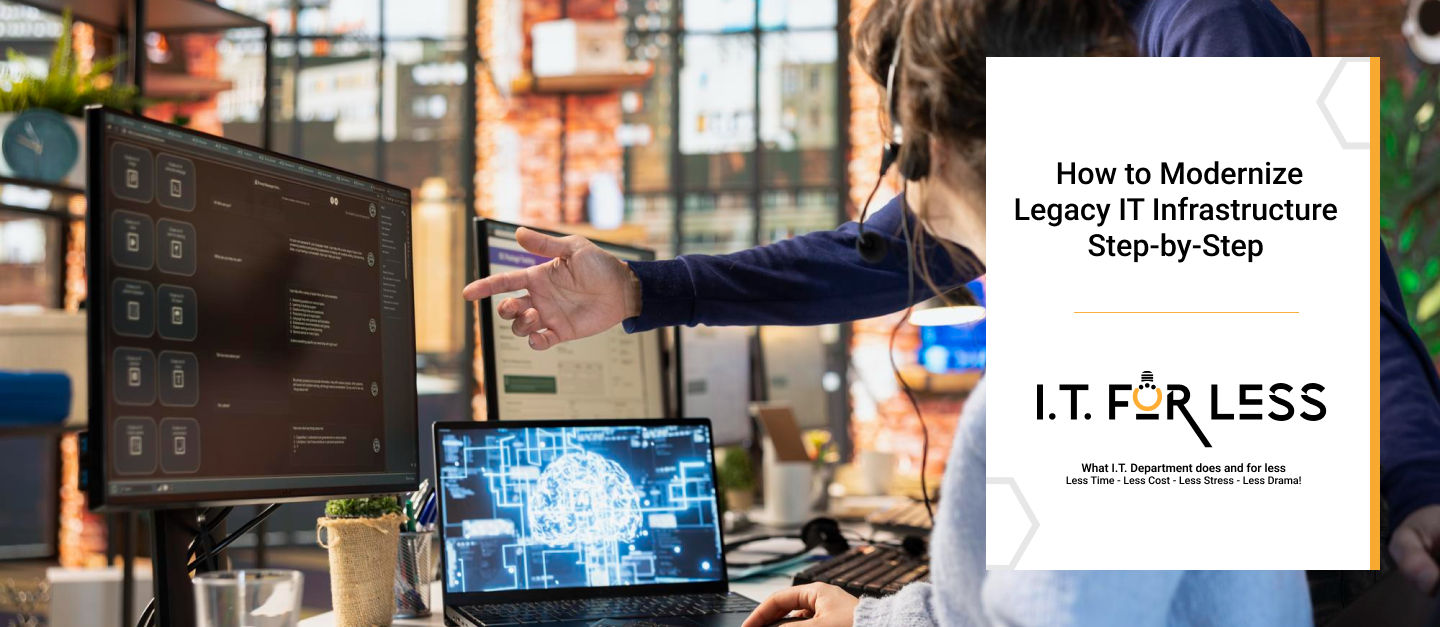Legacy systems often power mission-critical workflows—but they also slow delivery, inflate costs, and increase risk. Modernizing doesn’t have to mean a costly “rip and replace.” With a structured roadmap, you can transform safely, iteratively, and with measurable ROI.
Step 1: Define Business Outcomes (Not Just Tech Goals)
Clarify what modernization must achieve:
- Reduce downtime / MTTR
- Improve release velocity and quality
- Strengthen security & compliance
- Cut run costs or shift spend from “keep the lights on” to innovation
Document KPIs and constraints (budget, timelines, regulatory needs) up front.
Step 2: Baseline Your Current State
Create a pragmatic inventory:
- Assets: servers, VMs, databases, storage, network, endpoints
- Apps & dependencies: data flows, integration points, licenses
- Health metrics: availability, performance hotspots, incident patterns, costs
This becomes your source of truth and your before/after benchmark.
Step 3: Rationalize the Portfolio (The “7 Rs”)
Decide app by app:
- Retire (no longer needed)
- Retain (keep as-is for now)
- Rehost (lift-and-shift)
- Replatform (minor changes, e.g., managed DB)
- Refactor (modularize / cloud-native)
- Repurchase (move to SaaS)
- Replace (new build or product)
Prioritize high-value, low-risk wins first.
Step 4: Design the Target Architecture
Sketch the end state before you move:
- Hybrid/multi-cloud landing zones with guardrails
- Network & identity: Zero Trust, segmentation, SSO/MFA, least privilege
- Data architecture: backups, DR tiers, encryption, retention, lineage
- Resilience: multi-AZ/region, auto-scaling, blue-green/Canary releases
Step 5: Build the Foundations
Lay the plumbing so migrations are repeatable:
- Infrastructure as Code (IaC): standardized modules/templates
- CI/CD pipelines: automated build, test, deploy, rollback
- Observability: logs, metrics, traces, real user monitoring
- Secrets management & key management
- Automation: patching, config, backups, compliance checks
Step 6: Plan Migration Waves (Pilot → Scale)
Use a factory approach:
- Pick a pilot service with clear rollback
- Migrate data with the right pattern (snapshot, CDC, dual-run)
- Validate performance, security, and user experience
- Document runbooks; then scale wave by wave
Step 7: Modernize Data Safely
Treat data like a product:
- Classify (PII, regulated, business-critical)
- Choose storage patterns (managed DB, data lake/warehouse)
- Test integrity & performance under load
- Align RPO/RTO to business impact; practice restores
Step 8: Harden Security Throughout
Bake in, don’t bolt on:
- Baseline images, CIS benchmarks, continuous posture management
- Automated patching and dependency scanning
- Least-privilege IAM and just-in-time access
- End-to-end encryption and tokenization where needed
Step 9: Optimize for Cost and Performance
After each wave:
- Right-size instances, scale policies, storage classes
- Turn on autoscaling and scheduled scaling
- Use FinOps tags, budgets, and anomaly alerts
- Eliminate zombie resources and duplicate tools
Step 10: Upskill, Document, and Operationalize
People and process make it stick:
- Train teams on new platforms and pipelines
- Adopt SRE practices (SLOs, error budgets, blameless postmortems)
- Keep runbooks/current state architecture diagrams up to date
- Establish a continuous improvement cadence (quarterly)
Sample 90-Day Modernization Roadmap (Example)
- Days 1–30: Inventory & baselines; target architecture; IaC & CI/CD foundations
- Days 31–60: Pilot migration (low-risk app + managed database); observability live; security guardrails enforced
- Days 61–90: Two additional waves; cost/perf tuning; DR drill; documentation & handover
KPIs to Track
- Availability (%), MTTD/MTTR
- Change failure rate & deployment frequency
- Performance (p95 latency, throughput)
- Cost per service / per user, waste reclaimed
- Security posture (patch SLAs, misconfig counts)
- Backup success & restore time
Common Pitfalls to Avoid
- Big-bang migrations with no rollback plan
- Tool sprawl without clear ownership
- Lifting technical debt unchanged into the cloud
- Skipping DR tests and data integrity validation
- Ignoring identity, secrets, and least-privilege design
The Bottom Line
Modernization succeeds when it’s outcome-driven, foundation-first, and delivered in safe, iterative waves. Start small, codify everything, measure relentlessly, and scale what works.
Partner with I.T. For less today and take the first step towards making your I.T. flow as effortlessly as your ambition.
